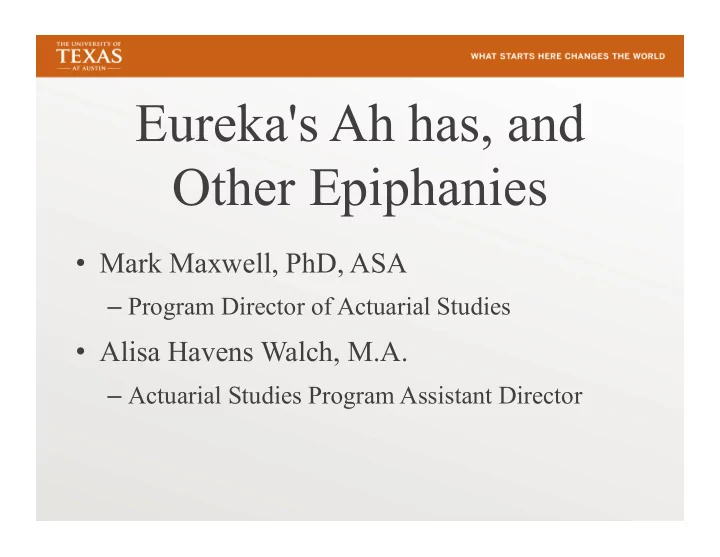

Eureka's Ah has, and Other Epiphanies • Mark Maxwell, PhD, ASA – Program Director of Actuarial Studies • Alisa Havens Walch, M.A. – Actuarial Studies Program Assistant Director
49 th ARC Money Quiz Read E[X]=n*p • $5.00 Answer • $1.00 Answer • -$1.00 Answer • -$5.00 Answer
Scoring Rubric for E[X]=n*p • $5.00 Answer: “I am unable to read the mathematical expression because the variables have not been defined.” • $1.00 Answer: “The expected value of a binomial random variable with n independent attempts/trials and fixed probability of success p is equal to the number of trials times the probability of success.” • -$1.00 Answer: “The expected value of X is equal to n times p .” • -$5.00 Answer: “E of X is ennpee.”
Flipping Probability • What is flipping? • Goals for students • Structure – Pre-class reading, synopsis, homework – In-class quizzes, team challenge questions, games, mini lectures – Post-class homework • Takeaway – The Chance Cube
“If something is important that students do, then you had better grade it.” -Ron Gebhartsbauer at the 48 th ARC held at Temple University
Actuarial Capstone Classes Second semester classes for MLC and C exams • “I’ll do whatever you like, except lecture.” • Successes – 18-page syllabus with a table of contents – Student groups created pre-class assignment – Small presentations and frequent in-class games – Grades = 1/3 content + 1/3 communication + 1/3 contribution • Opportunities for Future Successes – I need to communicate my expectations clearly (without limiting freedom) – E.g. Working groups 1) Determined subject relevant practice exam questions, created 2 exercises for peers, presented material to class, created a notebook for the next cycle. – Vetting of questions and presentations – Require at least 2 different presentation styles / teaching techniques
What’s New at UT? Alisa Havens Walch, M.A. Actuarial Studies Program Assistant Director University of Texas at Austin
New Classes • Generalized Linear Models – Introduced Spring 2014 • Property & Casualty Case Studies – To be offered Fall 2015
CAS Case Studies • Topics – Basketball Half-Court Shot (Probability) – Claims Liabilities – Warranty – Personal Auto Liability Rate Indication – CAT Modeling
CAS Case Studies • Materials – Case Study Description – PowerPoint Presentation with Speaker Notes – Audio Recordings to Accompany PowerPoint – Problem Sets & Solutions – Additional Materials
Automobile Insurance Case Study [Date of Presentation] [Name of Presenter]
Learning Objectives – Understand considerations in setting Automobile Liability Insurance Rates – Adjust historical premium levels – Adjust losses to ultimate loss levels – Reflect expenses in rates
What does an Insurance Rate Cover? � Losses � Expenses � Reasonable profit
What does the CAS say about ratemaking? � Statement of Principles Regarding Property and Casualty Insurance Ratemaking � Principle 1: – A rate is an estimate of the expected value of future costs.
What does the CAS say about ratemaking? � Statement of Principles Regarding Property and Casualty Insurance Ratemaking � Principle 2: – A rate provides for all costs associated with the transfer of risk.
What does the CAS say about ratemaking? � Statement of Principles Regarding Property and Casualty Insurance Ratemaking � Principle 3: – A rate provides for the costs associated with an individual risk transfer.
What does the CAS say about ratemaking? � Statement of Principles Regarding Property and Casualty Insurance Ratemaking � Principle 4: – A rate is reasonable and not excessive, inadequate, or unfairly discriminatory if it is an actuarially sound estimate of the expected value of all future costs associated with an individual risk transfer.
What do you need for a rate change indication? � Current rates and historical premium � Premium trend � Loss experience � Loss development triangles � Loss trend � Expenses � Credibility measure
How do you determine a rate change indication?
Adjustments to Premiums
Adjustments to Premiums � Earned Premium – Define Earned Premium – Adjust for historical rate changes • Want to calculate a factor to adjust historical premium to current rate levels – Trend • Premiums may increase year over year with inflation
Adjustments to Premiums � Adjust historical premium to current rate levels
Adjustments to Premiums � Adjust historical premium to current rate levels
Adjustments to Premiums � Adjust historical premium to current cost levels
Adjustments to Losses
Adjustments to Losses � Losses – Losses include payments to the claimant and the loss adjustment expenses incurred by the insurer – Loss Development • Use historical loss growth patterns to estimate future claims growth – Trend • Historical losses adjusted to prospective cost levels – ULAE • Unallocated Loss Adjustment Expense • Overhead costs for claims departments
Adjustments to Losses � Loss Development
Adjustments to Losses � Loss Development
Adjustments to Losses � Trend
Adjustments to Losses � ULAE
Expenses
Expenses � Fixed Expenses – Do not vary with premium or loss volume � Variable Expenses – Vary with premium or loss volume � Profit – Target profit expressed as a percent of written premium
Expenses
Expenses
Expenses
Indicated Rate Change
Credibility
Casualty Actuarial Society 4350 North Fairfax Drive, Suite 250 Arlington, Virginia 22203 www.casact.org
Recommend
More recommend